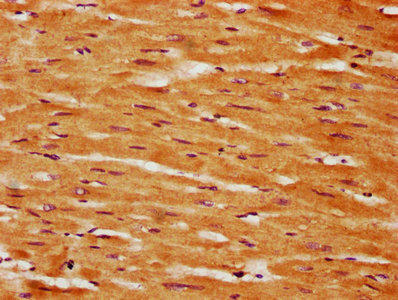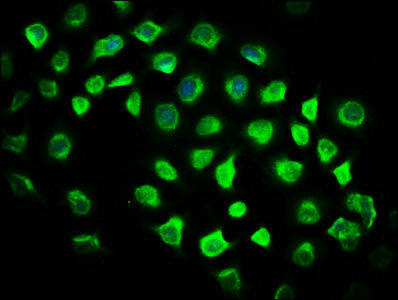Description
| Antibody Name: | GLIS2 Antibody (PACO61141) |
| Antibody SKU: | PACO61141 |
| Size: | 50ug |
| Host Species: | Rabbit |
| Tested Applications: | ELISA, IHC, IF |
| Recommended Dilutions: | ELISA:1:2000-1:10000, IHC:1:200-1:500, IF:1:50-1:200 |
| Species Reactivity: | Human |
| Immunogen: | Recombinant Human Zinc finger protein GLIS2 protein (332-505AA) |
| Form: | Liquid |
| Storage Buffer: | Preservative: 0.03% Proclin 300 Constituents: 50% Glycerol, 0.01M PBS, pH 7.4 |
| Purification Method: | >95%, Protein G purified |
| Clonality: | Polyclonal |
| Isotype: | IgG |
| Conjugate: | Non-conjugated |
 | IHC image of PACO61141 diluted at 1:350 and staining in paraffin-embedded human heart tissue performed on a Leica BondTM system. After dewaxing and hydration, antigen retrieval was mediated by high pressure in a citrate buffer (pH 6.0). Section was blocked with 10% normal goat serum 30min at RT. Then primary antibody (1% BSA) was incubated at 4°C overnight. The primary is detected by a biotinylated secondary antibody and visualized using an HRP conjugated SP system. |
 | Immunofluorescence staining of A549 cells with PACO61141 at 1:116, counter-stained with DAPI. The cells were fixed in 4% formaldehyde, permeabilized using 0.2% Triton X-100 and blocked in 10% normal Goat Serum. The cells were then incubated with the antibody overnight at 4°C. The secondary antibody was Alexa Fluor 488-congugated AffiniPure Goat Anti-Rabbit IgG(H+L). |
| Background: | Can act either as a transcriptional repressor or as a transcriptional activator, depending on the cell context. Acts as a repressor of the Hedgehog signaling pathway (By similarity). Represses the Hedgehog-dependent expression of Wnt4 (By similarity). Necessary to maintain the differentiated epithelial phenotype in renal cells through the inhibition of SNAI1, which itself induces the epithelial-to-mesenchymal transition (By similarity). Represses transcriptional activation mediated by CTNNB1 in the Wnt signaling pathway. May act by recruiting the corepressors CTBP1 and HDAC3. May be involved in neuron differentiation (By similarity). |
| Synonyms: | Zinc finger protein GLIS2 (GLI-similar 2) (Neuronal Krueppel-like protein), GLIS2, NKL |
| UniProt Protein Function: | GLIS2: Can act either as a transcriptional repressor or as a transcriptional activator, depending on the cell context. Acts as a repressor of the Hedgehog signaling pathway. Represses the Hedgehog-dependent expression of Wnt4. Necessary to maintain the differentiated epithelial phenotype in renal cells through the inhibition of SNAI1, which itself induces the epithelial-to-mesenchymal transition. Represses transcriptional activation mediated by CTNNB1 in the Wnt signaling pathway. May act by recruiting the corepressors CTBP1 and HDAC3. May be involved in neuron differentiation. Defects in GLIS2 are the cause of nephronophthisis type 7 (NPHP7). NPHP7 is an autosomal recessive disorder resulting in end-stage renal disease during childhood or adolescence. It is a progressive tubulo-interstitial kidney disorder histologically characterized by modifications of the tubules with thickening of the basement membrane, interstitial fibrosis and, in the advanced stages, medullary cysts. Belongs to the GLI C2H2-type zinc-finger protein family.Protein type: C2H2-type zinc finger proteinChromosomal Location of Human Ortholog: 16p13.3Cellular Component: nuclear speck; nucleusMolecular Function: protein bindingBiological Process: negative regulation of smoothened signaling pathway; negative regulation of transcription factor activity; negative regulation of transcription from RNA polymerase II promoter; negative regulation of transcription, DNA-dependent; positive regulation of transcription from RNA polymerase II promoter; positive regulation of transcription, DNA-dependentDisease: Nephronophthisis 7 |
| UniProt Protein Details: | |
| NCBI Summary: | This gene is a member of the GLI-similar zinc finger protein family and encodes a nuclear transcription factor with five C2H2-type zinc finger domains. The protein encoded by this gene is widely expressed at low levels in the neural tube and peripheral nervous system and likely promotes neuronal differentiation. It is abundantly expressed in the kidney and may have a role in the regulation of kidney morphogenesis. p120 regulates the expression level of this protein and induces the cleavage of this protein's C-terminal zinc finger domain. This protein also promotes the nuclear translocation of p120. Mutations in this gene cause nephronophthisis (NPHP), an autosomal recessive kidney disease characterized by tubular basement membrane disruption, interstitial lymphohistiocytic cell infiltration, and development of cysts at the corticomedullary border of the kidneys.[provided by RefSeq, Jan 2010] |
| UniProt Code: | Q9BZE0 |
| NCBI GenInfo Identifier: | 296434515 |
| NCBI Gene ID: | 84662 |
| NCBI Accession: | Q9BZE0.2 |
| UniProt Secondary Accession: | Q9BZE0,B3KX84 |
| UniProt Related Accession: | Q9BZE0 |
| Molecular Weight: | 55,689 Da |
| NCBI Full Name: | Zinc finger protein GLIS2 |
| NCBI Synonym Full Names: | GLIS family zinc finger 2 |
| NCBI Official Symbol: | GLIS2 |
| NCBI Official Synonym Symbols: | NKL; NPHP7 |
| NCBI Protein Information: | zinc finger protein GLIS2 |
| UniProt Protein Name: | Zinc finger protein GLIS2 |
| UniProt Synonym Protein Names: | GLI-similar 2; Neuronal Krueppel-like protein |
| Protein Family: | Zinc finger protein |
| UniProt Gene Name: | GLIS2 |
| UniProt Entry Name: | GLIS2_HUMAN |






